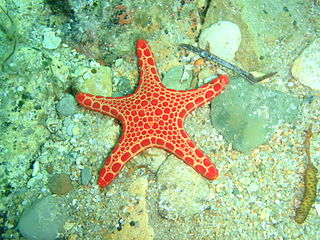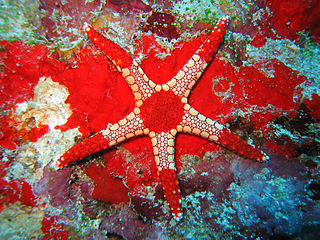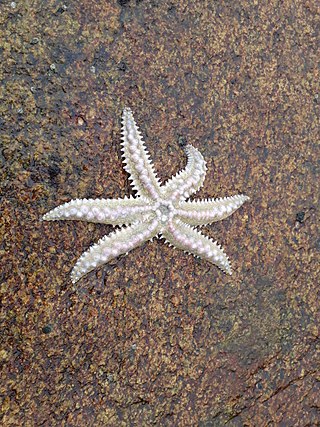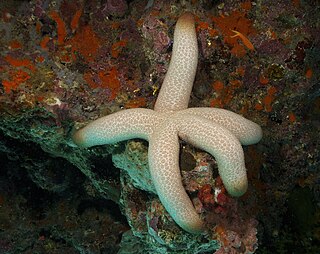
Starfish or sea stars are star-shaped echinoderms belonging to the class Asteroidea. Common usage frequently finds these names being also applied to ophiuroids, which are correctly referred to as brittle stars or basket stars. Starfish are also known as asteroids due to being in the class Asteroidea. About 1,900 species of starfish live on the seabed in all the world's oceans, from warm, tropical zones to frigid, polar regions. They are found from the intertidal zone down to abyssal depths, at 6,000 m (20,000 ft) below the surface.

The crown-of-thorns starfish, Acanthaster planci, is a large starfish that preys upon hard, or stony, coral polyps (Scleractinia). The crown-of-thorns starfish receives its name from venomous thorn-like spines that cover its upper surface, resembling the biblical crown of thorns. It is one of the largest starfish in the world.

The Ophidiasteridae are a family of sea stars with about 30 genera. Occurring both in the Indo-Pacific and Atlantic Oceans, ophidiasterids are greatest in diversity in the Indo-Pacific. Many of the genera in this family exhibit brilliant colors and patterns, which sometimes can be attributed to aposematism and crypsis to protect themselves from predators. Some ophidiasterids possess remarkable powers of regeneration, enabling them to either reproduce asexually or to survive serious damage made by predators or forces of nature. Some species belonging to Linckia, Ophidiaster and Phataria shed single arms that regenerate the disc and the remaining rays to form a complete individual. Some of these also reproduce asexually by parthenogenesis.

The common starfish, common sea star or sugar starfish is the most common and familiar starfish in the north-east Atlantic. Belonging to the family Asteriidae, it has five arms and usually grows to between 10–30 cm across, although larger specimens are known. The common starfish is usually orange or brownish in color, and sometimes violet; specimens found in deeper waters are pale. The common starfish is found on rocky and gravelly substrates where it feeds on mollusks and other benthic invertebrates.

Goniasteridae constitute the largest family of sea stars, included in the order Valvatida. They are mostly deep-dwelling species, but the family also include several colorful shallow tropical species.

Eledone schultzei, the brush-tipped octopus, is a rare species of octopus. It has previously been known by other taxonomic names (synonyms) including Eledone thysanophora and Aphrodoctopus schultzei.

Choriaster is monotypic genus in the family Oreasteridae containing the single species Choriaster granulatus commonly known as the granulated sea star. Other common names include big-plated sea star and doughboy starfish. This species is harmless to humans.

Fromia monilis, common name necklace starfish or tiled starfish, is a species of starfish belonging to the family Goniasteridae.
Ophidiaster granifer, the grained seastar, is a species of starfish in the family Ophidiasteridae. It is found in the Red Sea and the Indo-Pacific and is the only known species of starfish to reproduce by parthenogenesis.

Nepanthia belcheri is a species of starfish in the family Asterinidae. It is found in shallow water in Southeast Asia and northeastern Australia. It is an unusual species in that it can reproduce sexually or can split in two by fission to form two new individuals. As a result, it has varying numbers of arms, and Hubert Lyman Clark, writing in 1938, stated, "It is a literal truth that no two of the 56 specimens at hand, nearly all from Lord Howe Island, are exactly alike in number, size and form of arms".

Pocillopora verrucosa, commonly known as cauliflower coral, rasp coral, or knob-horned coral, is a species of stony coral in the family Pocilloporidae. It is native to tropical and subtropical parts of the Indian and Pacific Oceans.

Fromia milleporella, common name red starfish or black spotted starfish, is a species of starfish belonging to the family Goniasteridae.

Aquilonastra conandae is a species of starfish from the family Asterinidae found near the Mascarene Islands in the Indian Ocean. It is known for its asexual reproduction and is fissiparous. It is a small starfish, discrete and camouflaged, and occurs in coral reefs in the surf zone of large waves. The species was described in 2006 by Australian marine biologists P. Mark O'Loughlin and Francis Winston Edric Rowe, and gets its name from Chantal Conand.

Fromia elegans, common name little red star, is a species of marine starfish belonging to the family Goniasteridae.

Fromia ghardaqana, common name Ghardaqa sea star, is a species of marine starfish in the family Goniasteridae.

Fromia nodosa, commonly called elegant sea star, is a species of marine starfish belonging to the family Goniasteridae.

Fromia hemiopla, common name armoured sea star, is a species of marine starfish belonging to the family Goniasteridae,.

Meyenaster is a genus of starfish in the family Asteriidae. It is a monotypic genus and the only species is Meyenaster gelatinosus which was first described by the Prussian botanist and zoologist Franz Julius Ferdinand Meyen in 1834. It is found in the southeastern Pacific Ocean on the coasts of South America.

Thromidia catalai, sometimes called the heavy starfish, is a species of starfish in the family Mithrodiidae in the order Valvatida. It is native to the Indo-Pacific region. Thromidia catalai is one of the largest and heaviest starfishes in the world. It is reported to weigh as much as 6 kg (13 lb) and have a diameter of 60 to 65 cm. This species was first described by the Australian biologists E. C. Pope and F. W. E. Rowe in 1977, the type locality being New Caledonia.


















